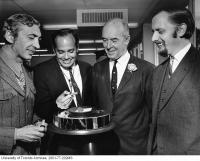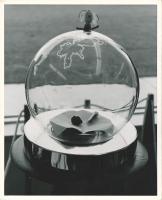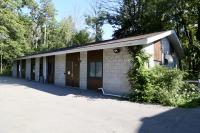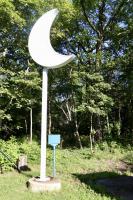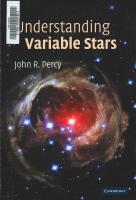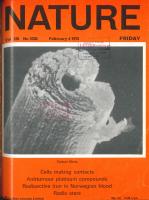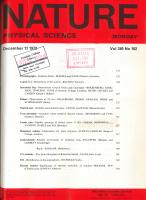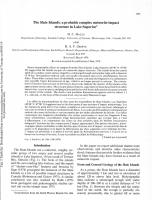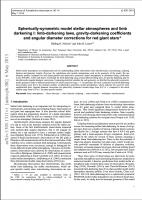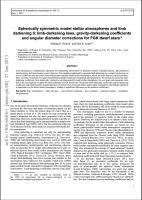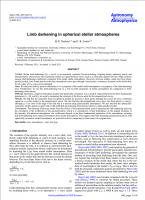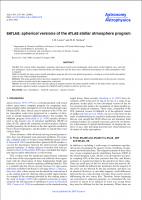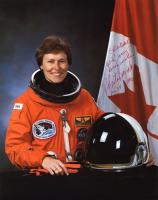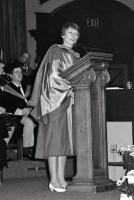Space and Discovery
Introduction
Astronomy is one of the most wide-ranging and oldest of the natural sciences. It embraces such topics as the origin and evolution of the planets, stars, galaxies and the whole universe; the conditions for the origin of life on earth and elsewhere; the behaviour of matter in environments never experienced on earth, and in general, the influence of the universe on mankind's thinking down through the ages. In 1967, Erindale College opened as a new constituent college of the University of Toronto and one of the original programs at the campus was Astronomy, which is now within the Department of Chemical and Physical Sciences. The program began with one faculty member, one teaching assistant and eight students. Over the years, the program has offered several courses on solar system astronomy, evolution of the stars and galaxies, and introduction to astronomical observation and analysis. Research within the program has been conducted from the David Dunlap Observatory in Richmond Hill and the Paleomagnetism Laboratory on Principal's Road near Lislehurst, with important contributions to the study of black holes, variable stars, stellar atmospheres. and meteorite impacts. This digital exhibit celebrates Science Literacy Week and the University of Toronto Mississauga's theme of Space and Discovery by showcasing the brief history of the campus, some important scientific contributions to astronomical and geological research, and the notable achievements of its alumni.
Moon Rocks
On 16 July 1969, the Apollo 11 spacecraft landed astronauts on the moon for the first time in human history. During the mission the astronauts had less than a few hours to complete a series of experiments, including the collection of rock samples from the lunar surface. With such little time to collect geological samples, the astronauts were trained to collect samples by David Strangway, the chief scientist of the physics branch at the NASA Johnson Space Center and professor of geophysics at Erindale College. Later in October after the astronauts had returned to Earth, Strangway was instrumental in bringing some of the moon rock samples to campus for research and to be displayed to the public. When the first lunar samples arrived and were exhibited, more than 3,000 people lined up for a peek at a moon rock no bigger than a golf ball and a thimbleful of moondust. Erindale College hosted the first public showing in Canada of the moon samples from 11-12 October 1969 in the North Building before they were relocated to the newly-built Physical Properties Laboratory for geological research.
Paleomagnetism Laboratory
In 1967, a proposal was made for a laboratory to conduct rock magnetic experiences where the earth's magnetic field could be virtually eliminated. Strangway helped land a federal grant to establish a Physical Properties Laboratory, now the Paleomagnetism Laboratory, where researchers investigated magnetic and electromagnetic properties of rocks—including moon rocks. The building of the laboratory was completed in 1969, with a “shielded” room subsequently added, in which experiments could be conducted in a magnetic field-free space. When the moon rocks came to campus in October 1969, the newly-built Laboratory was ready to study its magentic properties. One of the Laboratory's early scientific discoveries was that the moon rocks carried a magnetization, perhaps caused by a weak, long-extinct internally-generated magnetic field. To commemorate this spectacular event, Principal Tuzo Wilson had a light in the shape of a crescent moon erected outside the lab, which still stands today. On 22 May 2019, the Paleomagnetism Laboratory, variously known as the “Rock Lab” or “Lunar Lab” closed its doors for the last time, after 50 years of operation. The Laboratory along with the Lunar Light can be found along Principal’s Road that leads to Lislehurst , the Principal’s residence.
Variable Stars
Researchers of variable stars measure the nature and evolution of stars based on their brightness. The variability of stars may be due to geometric processes such as rotation, an eclipse by a companion star, or physical processes such as vibration, flares, or cataclysmis explosions. In each case, variable stars provide unique information about the properties of stars, and the processes that go on within them. John Percy, founding faculty member of UTM who taught astronomy from 1967 to 2007, spent his career studying variable stars and has been instrumental in outreach on astronomy education. Variable stars research is the leading area by which amateur and volunteer astronomers can contribute to astronomical research. The best source of information and opportunities is the American Association of Variable Star Observers (AAVSO). Percy also also put together extensive documentation on variable stars to help students gain their first experiences with research by developing and integrating their skills in science, math, and computing through the astronomical observations of variable stars.
Black Holes
From 1972 to 1973, Erindale College was fortunate to have Tom Bolton on staff as a postdoctoral researcher to replace John Percy while he was on leave. During that year Bolton made an important discovery and published one of the most significant research papers bearing the Erindale affiliation. While conducting astronomical observations at the Dunlap Observatory in Richmond Hill, Bolton pointed the telescope at Cygnus X-1 hoping to capture data on a neutron star. Instead, what he found was the first scientific evidence of a black hole. Bolton had observed the presence of the black hole by documenting evidence of the Star HDE 226868 as it "wobbled", as if it was orbiting around an invisible, but massive companion. With the absence of a companion star, his calculations demonstrated that the companion could be nothing less than a black hole. Bolton's discovery caused widespread debate as black holes had only been theoretical and the source of science fiction until that point. Today, the existence of black holes is widely-accepted in the scientific community.
Slate Islands Meteorite Impact
The Slate Islands in Lake Superior near Terrace Bay, Ontario mark the center of a large meteorite impact crater. Henry Halls, faculty emeritus in the Department of Chemical & Physical Sciences, discovered the Slate Islands meteorite impact site with research colleagues in 1973 based on analysis of shock metamorphic effects in samples from the islands. The islands form the central uplift of a complex crater and are ringed by a submerged trough and annular ridge with a diameter of 30 km. The orientations of shatter-cones present in the breccia host-rocks indicate the interior of the islands as the approximate shock centre. Microscopic features, equivalent to those described from other impact sites, reveal that the level of shock deformation increases towards the interior of the islands. Based on the erosion level, Hall found the meteoric event may have occurred in the Paleozoic Age, 450 million years ago. In addition to this important discovery in Lake Superior, Halls used the Paleomagnetism Laboratory to test samples and found that they contained a remanent magnetization caused by the high temperatures and shock pressure of the meteorite impact itself.
Stellar Atmospheres
Stellar atmospheres are the outer region of the volume of a star, lying above the core, radiation and convection zones. Stellar atmospheres are often used as tools for the study of macro topics, such as the evolution of the Milky Way or the distance to other galaxies. John Lester, current faculty member of the astronomy program, researches the astrophysics that takes place in the stellar atmosphere, which is an extremely complex boundary layer between the dense stellar interior and near vacuum of space. There are fundamental physical processes occurring in this environment that are still poorly understood because the size, temperatures, pressures, velocities and magnetic fields cannot be recreated in laboratories. Lester's approach to these problems is a combination of observation and computer modeling. Lester measures stellar radiation through spectroradiometry, which is the measurement of light energy at individual wavelengths within the electromagnetic spectrum. Lester developed a small Fourier Transform Spectrometer specifically designed to measure spectral irradiance while avoiding the systematic errors that have plagued spectroradiometry. The spectrometer is located at the Lowell Observatory, Flagstaff, Arizona, which is hosting this research project.
Roberta Bondar and Discovery
Graduating with her doctorate in neurobiology from the University of Toronto Mississauga in 1974, Roberta Bondar went on to become Canada's first female astronaut. On 22 January 1992, Bondar became the first Canadian woman, the second Canadian, and the first neurologist in space. She flew aboard space shuttle Discovery, the only Canadian and woman of the seven crew members of NASA Mission STS-42. The mission was originally planned to last ten days, but changes in shuttles due to repairs shortened it to eight days. During the mission, Bondar and the other astronauts conducted more than 40 experiments in the Spacelab and on the middeck to discover means to allow future astronauts to undertake longer flights in space. Bondar researched the nervous system, inner ear balancing system, eye functions and blood flow during microgravity. Upon her return to Earth, Bondar worked with a team of researchers to analyze data from her flight and other missions to better understand how human bodies recover from space travel. Bondar has received many honours including the Order of Canada, the Order of Ontario, the NASA Space Medal and induction into the Canadian Medical Hall of Fame.
Bibliography
Bolton, C.T. (Dec 11 1972). Dimensions of the Binary System HDE 226868 = Cygnus X-1. Nature, 240, p. 124-127.
Bolton, C.T. (February 4, 1972). Identification of Cygnus X-1 with HDE 226868. Nature, 235, p. 271-273.
Hamilton, J.D. (June 19, 1972). Distinguished Canadians: Tuzo WIlson. CBC Digital Archives. Retrieved from https://www.cbc.ca/archives/entry/distinguished-canadians-tuzo-wilson
Hamilton Public Library (2019). Roberta Bondar. Retrieved from https://www.hpl.ca/bondar-roberta
Halls, Henry. (July 26, 2019). Paleomagnetism Laboratory [1969-2019]. Retrieved from https://www.utm.utoronto.ca/cps/news/paleomagnetism-laboratory-1969-2019
Lester, J.B. & Nielson, H.R. (November 2011). Limb darkening in spherical stellar atmospheres. Astronomy and Astrophysics, 530, pp. A65.
Lester, J.B. & Neilson, H.R. (2008). SATLAS: Spherical versions of the ATLAS stellar atmosphere program. Astronomy and Astrophysics, 491(2), pp. 633-641.
Neilson, H. R. and Lester, J. B. (June 2013). Spherically-symmetric model stellar atmospheres and limb darkening. I. Limb-darkening laws, gravity-darkening coefficients and angular diameter corrections for red giant stars. Astronomy & Astrophysics, 554(A98), pp. 1-11.
Neilson, H. R. and Lester, J. B. (August 2013). Spherically symmetric model stellar atmospheres and limb darkening. II. Limb-darkening laws, gravity-darkening coefficients and angular diameter corrections for FGK dwarf stars",Astronomy & Astrophysics, 556(A86), pp. 1-8.
Percy, J. R. (2007). Understanding variable stars. Cambridge: Cambridge University Press.
Percy J.R. & Abbas, S. (2007). Celebrating 40 Years at the University of Toronto Mississauga. University of Toronto Mississauga. Retrieved from https://tspace.library.utoronto.ca/handle/1807/10268
Royal Astronomical Society of Canada. (n.d.) Retrieved from www.rasc.ca.
Smithsonian National Air and Space Museum (n.d.) Apollo 11 (AS-506). Retrieved from https://airandspace.si.edu/explore-and-learn/topics/apollo/apollo-program/landing-missions/apollo11.cfm
Stewart, J. (April 22, 2008). Storyteller Unveils Evolution of UTM. Mississauga.com. Retrieved from https://www.mississauga.com/community-story/3135998-storyteller-unveils-evolution-of-utm/
Stirling, J. & Wahl, N. (eds.) (2017). Spark: Five Decades of Distinction. The University of Toronto Mississauga Magazine. Retrieved from https://www.utm.utoronto.ca/sites/files/default/public/shared/advancement/pdfs/UTM_Spring2017_final.pdf
University of Toronto Mississauga (2017). UTM Timeline: From Pastures to Pedagogy. Retrieved from https://www.utm.utoronto.ca/utm50/timeline

